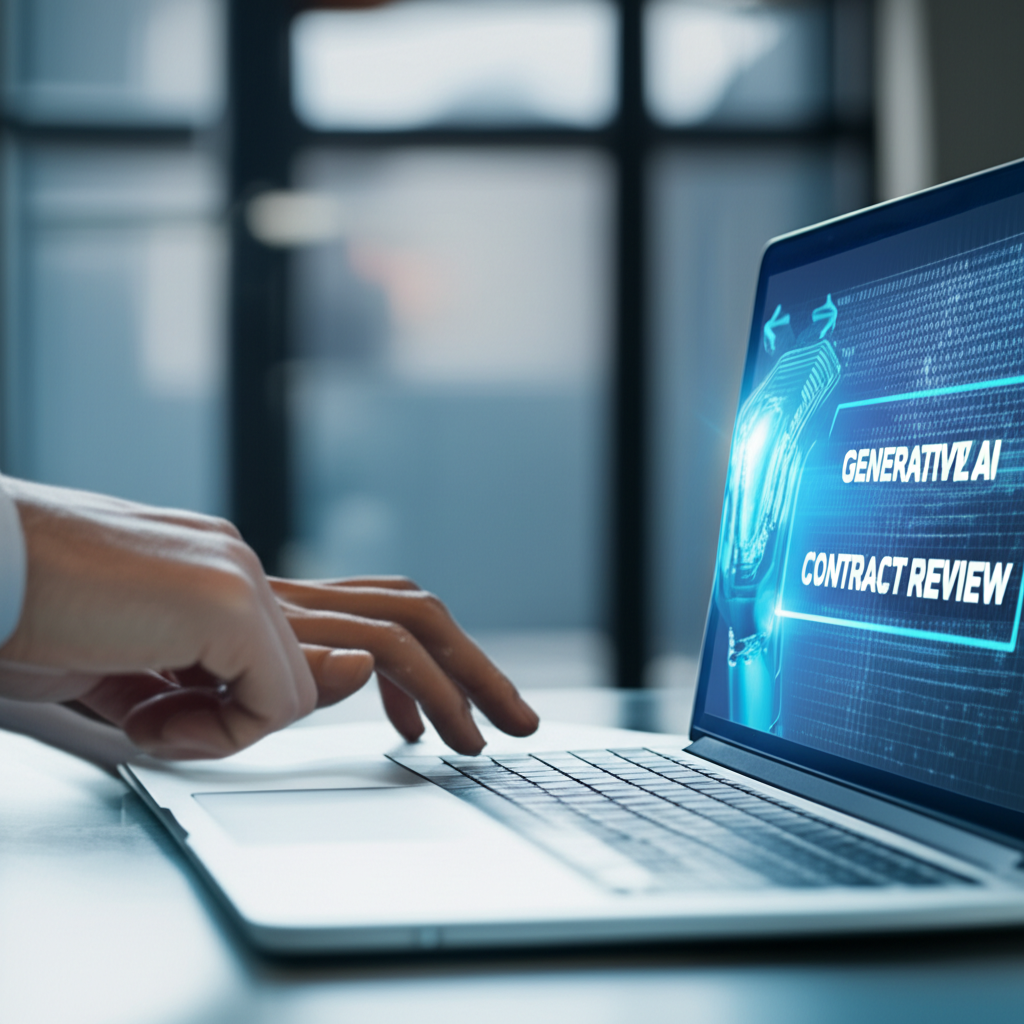Contracts move business. For law firms and legal departments, the difference between winning deals and managing risk often hinges on how fast and accurately you can review and negotiate agreements. Generative AI is redefining that speed–accuracy frontier. Used thoughtfully, it can surface issues in seconds, standardize positions, and protect privilege while freeing lawyers to focus on strategy and client counseling.
Table of Contents
- What Generative AI Brings to Contract Review
- Core Capabilities Across the Contract Lifecycle
- Practical Example: Copilot-Powered Review in Microsoft 365
- Comparing AI Contract Review Tools: Build vs. Buy
- Compliance, Security & Risk Mitigation
- Collaboration Upgrades with AI
- Workflow Optimization & Automation
- Ethical & Regulatory Considerations
- Metrics & KPIs for AI-Enabled Contract Review
- Future Trends
- Conclusion & Next Steps
What Generative AI Brings to Contract Review
Generative AI is not just making contract review faster; it is making it more consistent, explainable, and collaborative. Large language models (LLMs) can be “grounded” in your firm’s clause library, playbooks, and prior deals to quickly identify deviations, propose edits, and summarize impact in plain language. When connected to matter files through Microsoft 365 or a contract lifecycle management (CLM) platform, AI adds context—prior negotiations, accepted fallbacks, regulatory constraints—to raise quality while reducing rework.
For attorneys, this means fewer cycles spent on mechanical comparisons and more time advising on commercial implications. For clients, it means clearer explanations, quicker turnarounds, and defensible, auditable processes that align with their risk posture.
Core Capabilities Across the Contract Lifecycle
Pre-signature intake and triage
- Auto-classify incoming agreements (NDA, MSA, DPA, SOW, licensing, procurement) and route to the right team based on matter type, counterparty, or thresholds.
- Extract key fields (term, renewal, governing law, liability caps, data processing obligations) to populate matter records and approval workflows.
- Score complexity and risk to prioritize work and suggest the correct template or playbook.
Drafting and clause selection
- Generate first drafts from templates using deal facts, intake forms, and approved clause variants.
- Recommend alternative clauses based on jurisdiction, client preferences, or industry norms.
- Highlight missing provisions relative to your standard, and flag ambiguous language.
Review and redlining
- Compare a counterparty draft against your standard, calling out deviations and their commercial/legal impact.
- Propose redlines aligned to your playbook and explain the rationale for each edit in plain language.
- Translate dense provisions into client-friendly summaries without losing nuance.
Risk scoring, approvals, and handoffs
- Assign risk levels to clauses and entire documents, triggering approvals for high-risk positions (e.g., uncapped liability, broad indemnities, data transfers).
- Capture negotiation history and accepted fallbacks for future learnings.
- Push executed contracts and structured metadata to repositories for renewal tracking, obligations management, and eDiscovery.
- Intake: Email/portal submission auto-classified; key terms extracted; matter created.
- Grounding: AI references clause library, playbook, and prior matters in your tenant.
- Analysis: AI compares draft to standards; flags gaps; proposes edits with rationale.
- Collaboration: Comments and summaries shared in Teams channel; approvals triggered.
- Negotiation: Redlines iterated; AI tracks issues and accepted fallbacks.
- Finalization: eSignature completed; obligations and metadata pushed to repository.
- Post-signature: Alerts for renewals; obligations tracked; insights feed back to playbook.
Practical Example: Copilot-Powered Review in Microsoft 365
Below is a concrete, defensible workflow you can deploy with Microsoft 365 Copilot, Word, Teams, SharePoint, Power Automate, and your clause library.
- Store your gold-standard templates, clause library, and playbook in a secured SharePoint site, using sensitivity labels (e.g., Confidential – Client Work Product) via Microsoft Purview.
- When a counterparty sends a draft, save it to the matter folder. In Word, open Copilot and prompt: “Compare this MSA to our standard MSA template in the same matter folder. Identify deviations by clause, rate risk (Low/Med/High), and propose redlines consistent with our playbook.”
- Copilot’s analysis stays within your Microsoft 365 tenant and respects your permissions. Review its suggested edits and rationale before accepting changes. Use “Rewrite” to tighten language or “Explain” to generate a client-friendly summary.
- In Teams, use a channel dedicated to the matter. Paste Copilot’s clause-by-clause summary and ask: “Summarize these issues for the client in three bullets per topic and draft an executive summary email.” Validate, then send via Outlook.
- Trigger a Power Automate flow: if Copilot flags a High risk (e.g., uncapped liability), automatically route the document for partner approval with a summary attachment. Capture approval decisions in the matter record.
- Post-signature, a second flow files the executed contract, writes extracted metadata (term, renewal, jurisdiction) to a SharePoint list, and schedules renewal reminders in Planner.
Result: A repeatable, permission-controlled process that compresses review time, standardizes positions, and captures institutional knowledge—without leaving the Microsoft 365 environment where your work already lives.
Comparing AI Contract Review Tools: Build vs. Buy
Depending on your volume, matter profile, and integration needs, you may combine Microsoft 365 with legal-specific AI or adopt an end-to-end CLM solution. Here’s a snapshot:
| Tool/Platform | Primary Use | Deployment | Strengths | Best For |
|---|---|---|---|---|
| Microsoft 365 Copilot + SharePoint Premium (formerly Syntex) | General AI drafting, analysis, summarization; metadata extraction | Tenant-bound in M365; leverages your Graph permissions | Integrated with Word/Teams/Outlook; strong security/compliance; low friction | Firms wanting to augment existing processes without a new system |
| Ironclad (with AI Assist) | CLM with AI-driven intake, redlining, approvals | Cloud SaaS | Business-friendly workflows; strong playbook automation; dashboards | Legal ops teams standardizing enterprise contracting |
| Evisort | AI contract discovery, review, repository, and analytics | Cloud SaaS | Robust extraction; repository search; obligation tracking | Firms/departments focused on post-signature intelligence and review |
| Luminance | AI review for due diligence and compliance | Cloud/SaaS | Visual anomaly detection; multilingual analysis | Transactional and compliance-heavy practices |
| Litera Kira | ML-powered clause extraction and review | Cloud | Battle-tested for diligence; customizable models | High-volume M&A and finance diligence |
| Spellbook (by Rally) | AI drafting and review inside Microsoft Word | Word add-in | Clause suggestions; negotiation assists within Word | Attorneys seeking quick, in-document AI assistance |
| Harvey | General legal AI assistant | Cloud; enterprise integrations | Broad legal knowledge; adaptable workflows | Firms building AI workspaces across practice areas |
Tip: Start with your process and risk profile, then choose the minimum set of tools that solves persistent bottlenecks while meeting client and regulatory expectations.
Compliance, Security & Risk Mitigation
Security and confidentiality are non-negotiable in legal. The right architecture can harness AI without sacrificing privilege or client trust.
Data protection in practice
- Tenant-bound processing: In Microsoft 365, Copilot honors your identity, permissions, and sensitivity labels. It does not change document access or expose content a user cannot already see.
- Data loss prevention (DLP): Apply DLP policies and sensitivity labels (e.g., “Attorney–Client Privileged”). Block external sharing or copying for sensitive matter folders.
- Auditability: Enable audit logs and eDiscovery for AI-assisted edits and approvals to preserve a defensible chain of custody.
- PII and confidentiality: Use automated redaction on exports and ensure any external AI tool contractually commits to no training on your data.
Frameworks to align with
- ISO/IEC 27001 and SOC 2 Type II for information security management and controls.
- NIST AI Risk Management Framework to structure model risks, monitoring, and governance.
- GDPR/UK GDPR and CCPA/CPRA for personal data and data subject rights where applicable.
- Client mandates: Many enterprise clients specify encryption, residency, and logging requirements—mirror those in your configuration.
Best practice: Treat your AI configuration like a new practice system. Document your data flows, access controls, approved prompts, and human-in-the-loop checkpoints. Run tabletop exercises for “what if” scenarios (e.g., incorrect AI summary sent to client) and capture remediation steps.
Collaboration Upgrades with AI
AI enhances collaboration by turning unstructured conversations and drafts into shared, actionable knowledge—without adding administrative burden.
- Teams meeting intelligence: With Copilot in Teams and transcription enabled, lawyers can ask, “Summarize positions we agreed on and open issues from today’s negotiation.” Post the summary to the matter channel and convert unresolved items into Planner tasks.
- Client-facing updates: Use Copilot to translate technical provisions into business-oriented summaries that in-house clients can quickly approve.
- Shared channels with vendors or co-counsel: Keep external participants in separate channels. Maintain internal channels for privileged AI analysis and risk notes.
The outcome is a cleaner record of negotiations, quicker alignment across stakeholders, and fewer “lost” decisions buried in emails.
Workflow Optimization & Automation
Well-placed automation ensures the right person sees the right document at the right time and that critical metadata is captured once—correctly.
- Approval routing: Use Power Automate to trigger approvals if liability caps drop below thresholds or if data transfer clauses involve restricted jurisdictions.
- Obligation tracking: Extract obligations and renewal dates into SharePoint lists or a CLM repository. Notify matter teams 90/60/30 days before key dates.
- eSignature integration: Connect DocuSign or Adobe Acrobat Sign to push executed contracts back to the matter folder, apply final labels, and lock down permissions.
- Time capture: Use AI to suggest time entries from meeting summaries, emails, and document edits—always review before posting to your billing system.
Ethical & Regulatory Considerations
Lawyers must ensure AI augments—not replaces—professional judgment. Anchor your use of AI to core duties and transparent governance.
- Competence (ABA Model Rule 1.1): Maintain understanding of the benefits and risks of AI tools you use; train staff; keep playbooks current.
- Confidentiality (Rule 1.6): Ensure tools are configured to protect client information; restrict external data processing; review vendor DPAs.
- Supervision (Rules 5.1–5.3): Set written AI usage policies; review work product; monitor adherence; audit prompts and outputs.
- Client communication (Rule 1.4): Consider informing clients when AI materially contributes to work, especially if it affects staffing or billing.
- Bias and hallucinations: Require human review. Ban “blind acceptance” of AI redlines or summaries. Prefer grounded prompts with citations to your clauses.
- Ground prompts in your clause library and templates.
- Require a human reviewer to approve all redlines and client-facing summaries.
- Log prompts/outputs for high-risk agreements.
- Prohibit uploading client documents to consumer AI tools.
Metrics & KPIs for AI-Enabled Contract Review
To demonstrate value, track both speed and quality—then use the data to refine playbooks and training.
- Cycle time: Intake-to-signature median days, by agreement type.
- Issue recurrence: Frequency of escalations on the same clause—indicates playbook gaps.
- Edit acceptance: Percentage of AI-suggested redlines accepted without modification.
- Rework rate: Number of back-and-forth rounds pre- and post-AI adoption.
- Client satisfaction: Post-matter survey on clarity and speed.
- Risk outcomes: Incidents tied to contractual gaps or missed obligations.
Future Trends
Contract review will continue to evolve from document-centric to knowledge-centric operations. Expect:
- Agentic workflows: AI “agents” that monitor negotiations, propose next steps, and coordinate approvals across systems.
- Richer grounding: Seamless retrieval-augmented generation (RAG) across clause libraries, prior deals, regulatory databases, and client policies.
- Structured outputs: Automatic population of knowledge graphs and obligation trackers, enabling analytics and scenario planning.
- Privacy-preserving options: More on-tenant and region-specific processing, plus stronger audit and explainability features.
- Regulatory alignment: Built-in controls mapping to frameworks like NIST AI RMF and emerging AI-specific laws.
Conclusion & Next Steps
Generative AI is reshaping contract review from a manual, clause-by-clause exercise into a data-driven, collaborative, and auditable process. With Microsoft 365 Copilot and legal-focused AI platforms, you can reduce cycle times, standardize positions, and elevate the client experience—without compromising confidentiality or ethics. Start small with grounded prompts, clear guardrails, and measurable KPIs, then scale what works across matters and teams.
Want expert guidance on improving your legal practice operations with modern tools and strategies? Reach out to A.I. Solutions today for tailored support and training.




